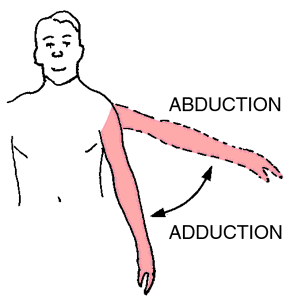adduction
[ah-duk´shun]the act of adducting; the state of being adducted.

Adduction versus abduction of arm. From Chabner, 1996.
Miller-Keane Encyclopedia and Dictionary of Medicine, Nursing, and Allied Health, Seventh Edition. © 2003 by Saunders, an imprint of Elsevier, Inc. All rights reserved.
ad·duc·tion
(ă-dŭk'shŭn), Do not confuse this word with abduction. In lecturing and dictation, some physicians pronounce the word "A D duction" to avoid ambiguity.1. Movement of a body part toward the median plane (of the body, in the case of limbs; of the hand or foot, in the case of digits).
2. Monocular rotation (duction) of the eye toward the nose.
3. A position resulting from such movement. Compare: abduction.
Farlex Partner Medical Dictionary © Farlex 2012
Adduction
The movement of a limb or other body part, usually on a transverse plane, toward the axis or midline—medial plane—of the body.Segen's Medical Dictionary. © 2012 Farlex, Inc. All rights reserved.
ad·duc·tion
(ă-dŭk'shŭn)1. Movement of a body part toward the median plane (of the body, in the case of limbs; of the hand or foot, in the case of digits) or midline of the body.
2. Monocular rotation (duction) of the eye toward the nose.
3. A position resulting from such movement.
Compare: abduction
Compare: abduction
Medical Dictionary for the Health Professions and Nursing © Farlex 2012
adduction
A movement towards the centre line of the body. Muscles which adduct are called adductors. The term derives from the Latin ad , to and ducere , to draw. Compare ABDUCTION.Collins Dictionary of Medicine © Robert M. Youngson 2004, 2005
adduction
Rotation of an eye towards the midline (Fig. A6). See duction; paralysis of the third nerve; Duane's syndrome.
Millodot: Dictionary of Optometry and Visual Science, 7th edition. © 2009 Butterworth-Heinemann
ad·duc·tion
(Ad) (ă-dŭk'shŭn)Movement of a body part toward the median plane (of the body, in the case of limbs; of the hand or foot, in the case of digits).
Medical Dictionary for the Dental Professions © Farlex 2012
